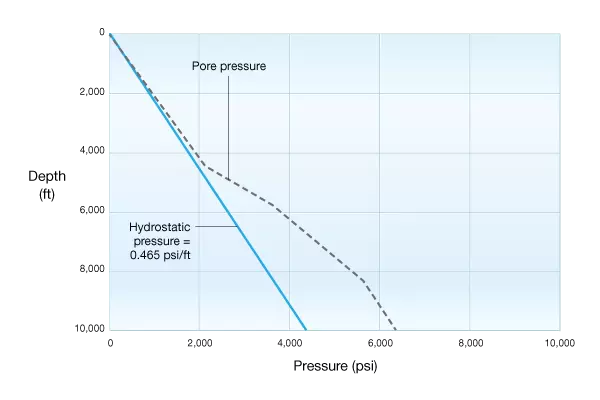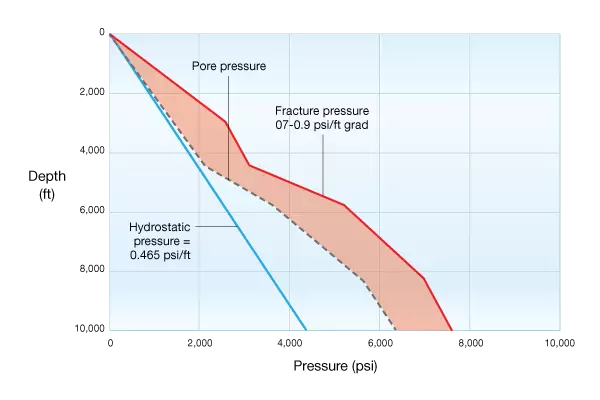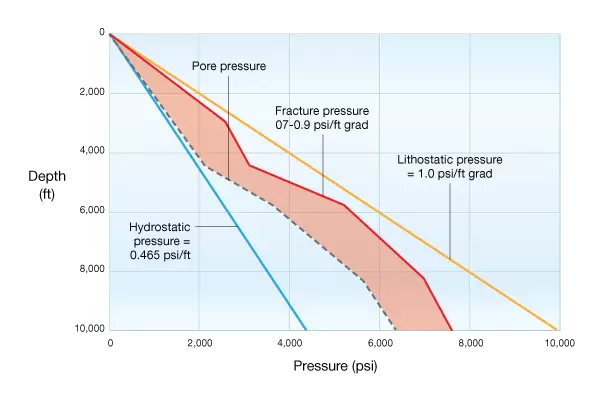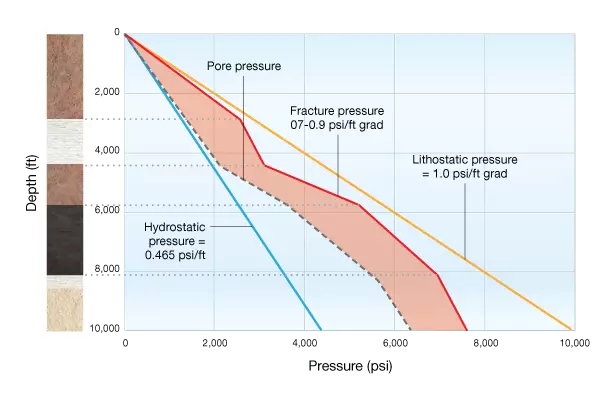Subsurface Pressure Gradient Profiles
A cementing plan must consider several pressure profiles within the subsurface so as to avoid unexpected consequences.
Pressure Profiles
Hydrostatic Pressure
Definition
Hydrostatic pressure is the expected pressure in the formation created by the continuous presence of water in interconnected pores from the formation to the surface. Because sedimentary rocks were formed in both continental and marine environments, the formation waters may be both fresh and salty along this path.
Gradient
The hydrostatic pressure gradient may range from 0.433 ![]() (8.33 ppg) for fresh water to 0.52
(8.33 ppg) for fresh water to 0.52 ![]() (10 ppg) for salt water. Typically a value of 0.465
(10 ppg) for salt water. Typically a value of 0.465 ![]() (8.95 ppg) is used. This pressure can be calculated using the equation:
(8.95 ppg) is used. This pressure can be calculated using the equation:
P = 14.7 + 0.052 × fluid density(ppg) × h(ft)

Pore Pressure
Definition
Pore pressure is the pressure of the fluids within the formation pores exposed to the wellbore.
Gradient
Normal pore pressure is equal to the hydrostatic pressure. However, there are geological situations where the pore pressure may be abnormally higher (over-pressured) or abnormally lower (under-pressured) than the hydrostatic pressure.

Fracture Pressure
Definition
Fracture pressure is the pressure required to fracture a formation or cause the formation to separate and take fluid.
Gradient
The fracture gradient of a formation is typically in the range of 0.7 — 0.9 ![]() of depth.
of depth.

Lithostatic Pressure
Definition
Lithostatic pressure is the pressure imposed by the weight of the overburden, in essence, the pressure required to lift the overburden.
Gradient
Because the density of sedimentary rocks is about 2.5 x that of water, the pressure gradient imposed by the weight of the overburden is estimated to be about 1.0 ![]() of depth.
of depth.

To avoid the inflow of fluids into the wellbore under any circumstance, the wellbore pressure needs to be higher than the pore pressure and lower than the fracture pressure unless a hydraulic fracture is planned. Even when these combined conditions are satisfied, the wellbore pressure cannot be so high that it causes a substantial loss of fluids into the formation. These fundamental conditions must be considered carefully in any cement plan.
These pore and fracture pressure profiles are measured in wells or, if no data exists, data from offset wells, basin models and seismic data are used as a first approximation for both drilling and cementing operations. Figure 1 illustrates the pore and fracture pressure profiles that may exist in subsurface formations penetrated by a well to be cemented. Note the target range, shown in the shaded area, between the pore pressure and the fracture pressure profiles. The wellbore pressure during cementing must fall within this range. In some cases it may be quite narrow.

 Petro Shine The Place for Oil and Gas Professionals.
Petro Shine The Place for Oil and Gas Professionals.



